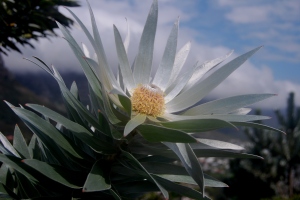Although the Proteaceae is instantly recognisable to anyone familiar with the flora of southern Africa, few people would consider this family to be among the top ten tree families. Of the 330 or so species in the region, approximately 75 species (~22%) can be (somewhat generously) classified as trees, with the rest being small or large woody shrubs. But, for the Proteaceae, we will be accommodating with our definitions.



I have written about the Proteaceae previously, commenting on the derivation of the name from the greek god Proteus (the sea god of ever changing form), and how wonderfully diverse the different plant forms can be. In spite of this diversity of form, there are, of course, some underlying similarities among the Proteaceae species in southern Africa: All species have simple, alternate, entire, leathery leaves (naturally, there is one exception, which we will get to); and the flowers are collected in showy heads or spikes. Each flower has four stamens, which are often fused to the sepals, leaving only the anthers free. If you have ever looked closely at a single flower (by zooming in on one of the impressive inflorescences) you may have noticed the long style pushing through the closely formed sepals. This feature serves a very important function: by brushing up against the anthers and then extending through the sepals, the style presents pollen to pollinators. Large beetles and birds (e.g. the sugarbird, Promerops caffra) obligingly collect the pollen (although they are more interested in the nectar) by sitting on top of the inflorescences.
The two great subfamilies: Proteoideae and Grevilleoideae
There are two major subfamilies in southern Africa: the Proteoideae and the Grevilleoideae [1]. Most people are familiar with the former subfamily, due in no small part to the ecological, cultural and economic importance of Protea species from South Africa’s south-western region (these species constitute a major part of the Fynbos flora) [2]. Some Proteoideae species, like the silver tree (Leucadendron argenteum), even form genuine trees.
However, very few South Africans will be familiar with the other major subfamily of the Proteaceae: the Grevilleoideae. Most of the species in this subfamily are found in Australia and south east Asia and South America (e.g. Grevillea, Banksia and Macadamia). However, one of the Proteaceae species most deserving of “tree status” is in the Grevilleoideae subfamily: Brabejum stellatifolium. Brabejum stellatifolium is a small tree (<15m) found in moist habitats throughout the southern Western Cape region of South Africa. It has small spikes of white flowers, which when pollinated produce clusters of rusty-brown, velvet fruits. Brabejum is the only representative of the Grevilleoideae subfamily on the African continent, although Macadamia is commonly planted for it’s nuts (and apparently there are native species related to Macadamia on Madagascar!). Members of the Proteoideae and Grevilleoideae can be separated by their floral form: Proteoideae species have flowers borne singly in the axil of a bract, but in the Grevilleoideae each bract subtends two flowers. Thus, if a flowering spike of Brabejum is examined, it will be seen to have two flowers in the axil of each bract! Another feature of the Grevilleoideae is that the leaves are whorled and toothed, as you can see from the picture below:

Part of our unique heritage
Culturally and economically, the proteoids are a highly important group. The cut-flower industry uses many proteoids (e.g. proteas, pincushions, blushing brides, conebushes). Proteoids are a popular – and stunning – choice for bouquets for wedding couples. Stylised proteoids also adorn many cultural artifacts, including Protea cynaroides on South Africa’s 20c coin, and form the basis of institutional emblems, such as the Protea repens used for South Africa’s Botanical Society.
Notes
[1] There are five subfamilies in total: the Persoonioideae, Bellendenoideae, Symphionematoideae, Proteoideae and Grevilleoideae.
[2] I recommend John Rourke’s excellent book on Proteas to anyone who is interested in discovering more about these wonderful “trees”:






2 thoughts on “Family of many forms”